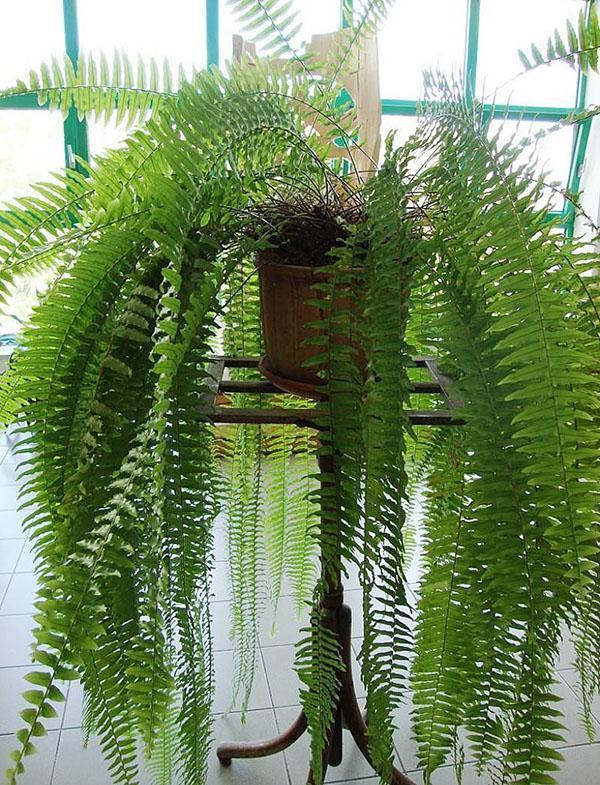Caring for nephrolepis at home is not difficult
 The fern world is extraordinarily vast, and many species are successfully grown as indoor crops. Among the most hardy and grateful is nephrolepis, the care and cultivation of which even a beginner in floriculture can handle.
The fern world is extraordinarily vast, and many species are successfully grown as indoor crops. Among the most hardy and grateful is nephrolepis, the care and cultivation of which even a beginner in floriculture can handle.
The genus Nephrolepis, which unites about 40 independent species, includes both terrestrial ferns and true epiphytes. Most of the plants are from the subtropical and tropical regions of the western and eastern hemispheres. When creating conditions for this flower in an apartment, you need to take into account its natural preferences and habits.
Lighting for nephrolepis

But on the south side, the lighting for nephrolepis is clearly inappropriate. Its excess leads to yellowing and drying of the leaves, the fern looks depressed, the existing frond slows down growth, very rarely new ones appear.
If there is no alternative to the southern window, it is better to bring the nephrolepis pot into the back of the room or place a shading screen between the fern and glass.
Temperature and humidity for nephrolepis
 Nephrolepis does not tolerate dry air and long exposure to cool temperatures below +12 ° C. Most plants from humid subtropical forests and tropics would not be able to triple comfortably in a city apartment. However, this genus of ferns is very hardy. If artificially maintain high air humidity, the temperature for nephrolepis can be + 16-25 ° C. In hotter air, the plant looks depressed, but comes to life if it is regularly sprayed or irrigated the crown.
Nephrolepis does not tolerate dry air and long exposure to cool temperatures below +12 ° C. Most plants from humid subtropical forests and tropics would not be able to triple comfortably in a city apartment. However, this genus of ferns is very hardy. If artificially maintain high air humidity, the temperature for nephrolepis can be + 16-25 ° C. In hotter air, the plant looks depressed, but comes to life if it is regularly sprayed or irrigated the crown.
In winter, when growth activity decreases, the temperature is lowered and the pot must be removed away from radiators and other heat sources. Big enemy fern - draft. So that caring for nephrolepis is not in vain, you should not put the plant under an open transom or near a balcony door.
As in summer, in winter, a warm shower with soft water is regularly arranged for the fern. Before "water procedures", the soil is covered with a film or other moisture-proof material.
Watering nephrolepis
 When growing nephrolepis at home, caring for a flower is impossible without properly organized watering. On the one hand, a fern is a culture that requires constant soil moisture. But on the other hand, excess moisture is a sure way to the development of rot, the spread of pests, the loss of decorativeness and the death of the plant.
When growing nephrolepis at home, caring for a flower is impossible without properly organized watering. On the one hand, a fern is a culture that requires constant soil moisture. But on the other hand, excess moisture is a sure way to the development of rot, the spread of pests, the loss of decorativeness and the death of the plant.
The root system of most species of this fern does not penetrate deeply into the soil, but at the same time forms a dense ball under the very surface of the soil. To exclude drying out that is dangerous for the culture and to prevent soil acidification from stagnant moisture, it is better to use watering of nephrolepis from a pallet. Mulching the surface with dry sphagnum or fine expanded clay will help preserve water in the soil. The use of home air humidifiers helps in the fight against drying out of the soil and the whole flower.
When caring for nephrolepis, whether it is watering or spraying, you need to take soft, settled or filtered water. Its temperature should be slightly higher than room temperature.
In winter, it is especially important to prevent the accumulation of moisture in the pot and the pallet under it. If the soil under the nephrolepis is still acidic, it is better to carry out an unscheduled transplant and replace the spoiled soil.
Soil for nephrolepis and fern feeding
 Under normal conditions, the transplant is carried out in the spring and is often combined with the reproduction of the fern by dividing the rhizomes. In order for a specimen transferred to a new pot to quickly acclimatize and grow, they purchase ready-made soil for ferns for it or prepare a mixture on their own.
Under normal conditions, the transplant is carried out in the spring and is often combined with the reproduction of the fern by dividing the rhizomes. In order for a specimen transferred to a new pot to quickly acclimatize and grow, they purchase ready-made soil for ferns for it or prepare a mixture on their own.
The plant feels comfortable in a slightly acidic or neutral substrate, which perfectly permeates water, air and does not interfere with the development of the root system. If the soil is done by hand when caring for nephrolepis and growing it at home, add to it in equal parts:
- fertile garden land;
- sorted out peat;
- well washed river sand;
- soil from coniferous crops.
Chopped sphagnum and chopped charcoal can be a useful component. These additives not only structure the substrate, but also protect the plant from bacterial flora and decay.
If the acidity of the soil for nephrolepis is outside the pH range of 5.0–6.0, units, dolomite flour must be added.
From spring to autumn, the fern is fed twice a month using complex fertilizers for decorative and deciduous crops. In winter, the frequency of feeding is reduced to once a month.
Difficulties in caring for nephrolepis
 The main symptom that signals problems is yellowing, drying and dropping of complex-pinnate elongated wai. There can be many reasons for this. What are the main difficulties in caring for nephrolepis awaiting a grower?
The main symptom that signals problems is yellowing, drying and dropping of complex-pinnate elongated wai. There can be many reasons for this. What are the main difficulties in caring for nephrolepis awaiting a grower?
Most often, the indoor plant lover has to deal with the natural process of renewing the green part of the plant. The old ones are replaced by young ones. At the same time, the crown is not exposed, it looks elastic, alive and healthy. In this case, dry fronds are carefully removed and the soil under the flower is cleaned.
Another thing is the loss of decorativeness due to a violation of the care of nephrolepis. Leads to leaf fall:
- systematic drying out of the earthen coma;
- excessive watering, which caused the appearance of root rot;
- the wrong place for a flower, in which the plant suffers from an excess of light or a draft.
Slower growth is usually associated with low temperatures, lack of nutrition, or free potting. The last two cases, difficulties in caring for nephrolepis are solved by transplanting or establishing a feeding regime.
 A common florist's mistake is the refusal to sterilize or disinfect the soil before planting a houseplant. Only spider mites, annoying in excessively dry air, or scale insects brought from the garden can settle on dense leathery fern frond. But the number of soil pests is much higher. Nephrolepis is threatened by putrefactive bacteria and pathogenic fungi, mealybugs, thrips. Complex treatment with insecticides and fungicides will help to cope with them. If there is a nematode in the soil, then the flower will inevitably die.
A common florist's mistake is the refusal to sterilize or disinfect the soil before planting a houseplant. Only spider mites, annoying in excessively dry air, or scale insects brought from the garden can settle on dense leathery fern frond. But the number of soil pests is much higher. Nephrolepis is threatened by putrefactive bacteria and pathogenic fungi, mealybugs, thrips. Complex treatment with insecticides and fungicides will help to cope with them. If there is a nematode in the soil, then the flower will inevitably die.